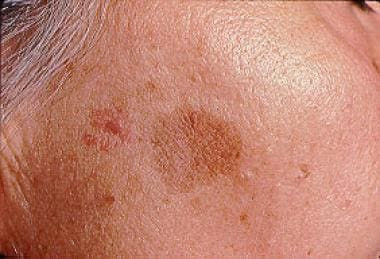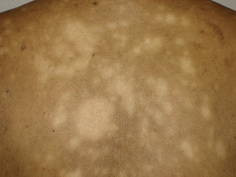Definisi
Lentigo adalah bintik atau bercak pigmentasi (berwarna lebih gelap dari kulit) pada kulit yang datar atau sedikit menimbul dengan batas yang tegas. Berbeda dengan efelis (freckle), lentigo tidak menghilang saat musim dingin. Istilah lentigo berasal dari bentuknya yang menyerupai lentil (kacang) kecil.
Lentigo terdapat di seluruh belahan dunia, dengan jumlah yang berbeda-beda tergantung dengan tipe lentigo.
Penyebab
Penyebab terbentuknya lentigo bergantung pada tipenya, yaitu:
- Penyebab lentigo simpleks tidak diketahui. Beberapa kasus lentigo simpleks pada anak-anak dilaporkan terjadi setelah penggunaan krim takrolimus yang digunakan untuk mengobati dermatitis atopi (dermatitis alergi)
- Lentigo solaris dan ink spot berhubungan dengan paparan sinar matahari pada orang berkulit putih. Paparan tersebut dapat berasal dari sunburn, tanning indoor, serta fototerapi, terutama fotokemoterapi (PUVA). Paparan sinar ultraviolet yang berulang dapat mencetuskan kerusakan DNA yang menyebabkan meningkatnya produksi melanin (pigmen kulit)
- Lentigo radiasi disebabkan oleh radiasi lokal dosis tinggi, misalnya pada terapi radiasi
- Faktor genetik dapat berperan dalam pembentukan tipe lentigo yang lain, seperti XP, sindrom LEOPARD, sindrom PEUTZ-Jeghers, dan lentigo berpola yang diturunkan
Faktor Risiko
Lentigo dapat mengenai pria dan wanita pada semua kelompok usia dan ras. Faktor yang meningkatkan risiko terkena lentigo berbeda-beda tergantung jenis lentigo.
- Lentigo solaris yang disebabkan oleh paparan sinar ultraviolet terutama banyak ditemukan pada orang dewasa berkulit putih dibandingkan kulit gelap, karena pada orang kulit gelap lebih banyak pigmen kulit alami yang melindungi dari paparan ultraviolet.
- Lentigo berpola yang diturukan dapat ditemukan pada orang kulit hitam, terutama keturunan Amerika India dan pada orang yang memiliki saudara dengan rambut berwarna merah.
- Lentigo PUVA, lentigo tanning-bed, lentigo ink spot lebih umum ditemukan pada orang berkulit putih
- Lentigo PUVA lebih sering ditemukan pada pria dibandingkan wanita
- Lentigo tanning-bed lebih umum ditemukan pada wanita dibandingkan pria
Lentigo dapat terjadi pada anak-anak dan orang dewasa, namun anak-anak lebih mungkin untuk terkena lentigo yang berhubungan dengan sindrom tertentu. Lentigo ada yang dihubungkan dengan beberapa sindrom yang muncul saat lahir atau saat masa kanak-kanak.
Gejala
Lentigo dapat berjumlah satu, namun lebih sering banyak. Kebanyakan lentigo memiliki diameter yang lebih kecil dari 5 mm. Lentigo dikelilingi oleh kulit yang normal. Lentigo dapat muncul secara perlahan dalam beberapa tahun, atau dapat muncul seketika. Warna lentigo dapat sama atau bervariasi dari kecokelatan sampai kehitaman.
Lentigo dibagi menjadi beberapa tipe yang berbeda bergantung dari penampakannya, lokasinya pada tubuh, faktor penyebabnya, dan apakah berhubungan dengan penyakit atau kondisi lain. Beberapa tipe lentigo adalah:
- Lentigo simpleks. Lentigo ini timbul saat masa kanak-kanak dan awal usia dewasa. Perubahan ditemukan pada badan dan anggota gerak tubuh. Lentigo ini berukuran kecil, berwarna cokelat, berbentuk bulat atau oval, bisa datar atau timbul. Batas lentigo ini dapat beraturan atau tidak beraturan dan permukannya dapat kering. Lentigo simpleks dapat hilang seiring berjalannya waktu.
- Lentigo solaris. Lentigo ini merupakan pendahulu dari keratosis seboroik (benjolan seperti kutil). Bagian tubuh yang sering terkena adalah bagian yang sering terpapar sinar matahari seperti tangan, wajah, dan tungkai bagian bawah. Selain itu, sunburn paad bahu juga dapat menyebabkan timbulnya lentigo solaris. Permukaan lentigo ini kering dan pinggirannya sering menyerupai bentuk gigitan ngengat (moth-eaten). Lentigo solaris dapat membesar secara perlahan sampai diameternya mencapai beberapa sentimeter. Namun, lentigo ini juga dapat hilang, seringnya akibat proses keratosis likenoid. Lentigo yang penampakannya tidak umum dapat sulit dibedakan dengan melanoma (kanker kulit) tahap awal.
- Lentigo ink spot atau lentigo retikularis. Jumlah lentigo ini lebih sedikit dibandingkan lentigo solaris. Lentigo ini timbul setelah terjadi sunburn pada orang berkulit putih. Bentuk lentigo ini tidak beraturan dan berwarna cokelat tua sampai kehitaman.
- Lentigo PUVA. Lentigo ini mirip dengan lentigo ink spot namun ditemukan setelah fotokemoterapi (PUVA). Lokasi ditemukannya adalah bagian tubuh mana saja yang terpapar PUVA
- Lentigo tanning bed. Lentigo ini juga mirip dengan lentigo ink spot namun terjadi setelah kegiatan tanning indoor. Lokasi ditemukannya adalah pada bagian tubuh yang terpapar oleh tanning bed
- Lentigo radiasi. Lentigo ini muncul pada area tubuh yang terpapar radiasi. Kondisi ini berhubungan dengan adanya dermatitis radiasi (peradangan kulit akibat radiasi) stadium lanjut.
- Makula melanotik atau melanosis mukosa. Lentigo ini timbul pada permukaan selaput lendir atau kulit berambut didekatnya seperti bibir, vulva, penis, dan anus. Warna lentigo ini adalah cokelat tua.
- Lentigo generalisata atau lentigo multipel. Lentigo ini ditemukan pada area tubuh baik yang tertutup atau terpapar dunia luar dari masa kanak-kanak awal. Bercak-bercak kecil dapat bergabung membentuk bercak yang lebih besar. Lentigo ini tidak berkaitan dengan sindrom tertentu.
- Lentigo berpola. Seseorang dengan lentigo ini memiliki kecenderungan yang diturunkan untuk mendapatkan lentigo pada wajah, bibir, pantat, telapak tangan, dan telapak kaki. Lentigo ini terutama banyak dijumpai pada etnis Afrika.
- Sindrom lentiginosis. Sindrom ini meliputi LEOPARD/Noonan, Peutz-Jeghers, Lugier-Hunziker, dan lain-lain. Sindrom ini diturunkan dan ditandai dengan lentigo yang tersebar luas pada tubuh yang sudah timbul sejak lahir atau muncul pada masa kanak-kanak awal. Sindrom ini berkaitan dengan tumor saraf, endokrin, dan mesenkim.
Diagnosis
Dokter biasanya mendiagnosa lentigo dengan melihat penampakannya pada kulit. Jika terdapat kecurigaan adanya melanoma (kanker kulit), maka akan dilakukan :
- Pemeriksaan dermatoskopi merupakan suatu tindakan untuk melihat struktur kulit yang lebih dalam
- Biopsi adalah pengambilan jaringan tubuh untuk dilakukan pemeriksaan di bawah mikroskop
Tata Laksana
Kebanyakan lentigo tidak membutuhkan terapi. Percobaan untuk mencerahkan warna lentigo tidak selalu berhasil. Terapi yang dapat diberikan adalah:
- Tabir surya spektrum luas dengan SPF 50+
- Krim bleaching hidrokuinon
- Asam hidroksi alfa
- Vitamin C
- Retinoid
- Asam azaleat
- Krim sisteamin
- Peeling. Terapi lentigo solaris menggunakan peeling kimia dapat lebih baik dibandingkan krioterapi (terapi dingin untuk menghilangkan tumor), karena efek sampingnya lebih sedikit (efek samping yang dimaksud adalah nyeri dan bercak cerah pada kulit atau hipopigmentasi).
Setelah beberapa bulan penggunaan, krim dengan kandungan di atas dapat mencerahkan lentigo.
Lentigo tunggal dapat dihilangkan secara permanen dengan menggunakan:
- Krioterapi. Terapi ini merupakan terapi sederhana untuk lentigo tunggal. Banyak ahli yang memilih krioterapi sebagai terapi pilihan pertama untuk lentigo solaris. Prosedur ini memiliki tingkat keberhasilan yang tinggi karena melanosit (sel yang memproduksi melanin) sensitif terhadap pembekuan oleh nitrogen cair. Melanosit akan membeku pada suhu -4 sampai -7.
- Asam trikloroasetat 33%.
- Laser pigmen atau short-pulsed untuk menghancurkan pigmen dalam lentigo solaris. Terapi ini dapat menghasilkan perbaikan yang signifikan tanpa efek samping yang mengkhawatirkan.
- Intense pulsed-light (IPL) merupakan perawatan dengan memanfaatkan gelombang cahaya.
Krioterapi lebih efektif dibandingkan dengan asam trikoloroasetat 33% dalam penanganan lentigo solaris pada punggung dan tangan, terutama pada orang yang berkulit putih. Kedua terapi tersebut memiliki risiko timbulnya penggelapan kulit pada kulit yang dilakukan terapi.
Komplikasi
Lentigo merupakan keadaan yang jinak dan biasanya menetap, tidak mudah hilang, serta dapat bertambah jumlahnya seiring bertambahnya usia dan paparan sinar matahari. Lentigo pada bagian yang terlindung dari matahari dapat memudar dan kemudian menghilang.
Pada wanita khususnya, lentigo dapat mengganggu dari segi estetika.
Pencegahan
Lentigo yang berhubungan dengan paparan radiasi ultraviolet dapat dicegah dengan melindungi diri dari matahari. Menutup bagian tubuh dengan pakaian lebih efektif untuk mencegah lentigo baru dibandingkan dengan menggunakan tabir surya. Selain itu, wanita juga sebaiknya berhati-hati dalam menggunakan tanning-bed.
Kapan harus ke Dokter?
Anda sebaiknya berkonsultasi ke dokter jika Anda menyadari adanya perubahan pada lentigo, seperti perubahan ukuran, bentuk, atau warna, serta jika gatal atau berdarah.
Mau tahu informasi seputar penyakit lainnya? Cek di sini, ya!
- dr Nadia Opmalina
Lentigo: Causes, Features, and Treatment — DermNet. Dermnetnz.org. (2022). Retrieved 3 May 2022, from https://dermnetnz.org/topics/lentigo.
Lentigo Treatment & Management: Medical Care, Surgical Care, Prevention. Emedicine.medscape.com. (2022). Retrieved 3 May 2022, from https://emedicine.medscape.com/article/1068503-treatment#d9.
Gangguan Kosmetik Karena Kelainan Pigmentasi Kulit. Jurnal.ugm.ac.id. (2022). Retrieved 3 May 2022, from https://jurnal.ugm.ac.id/bik/article/view/4645.












